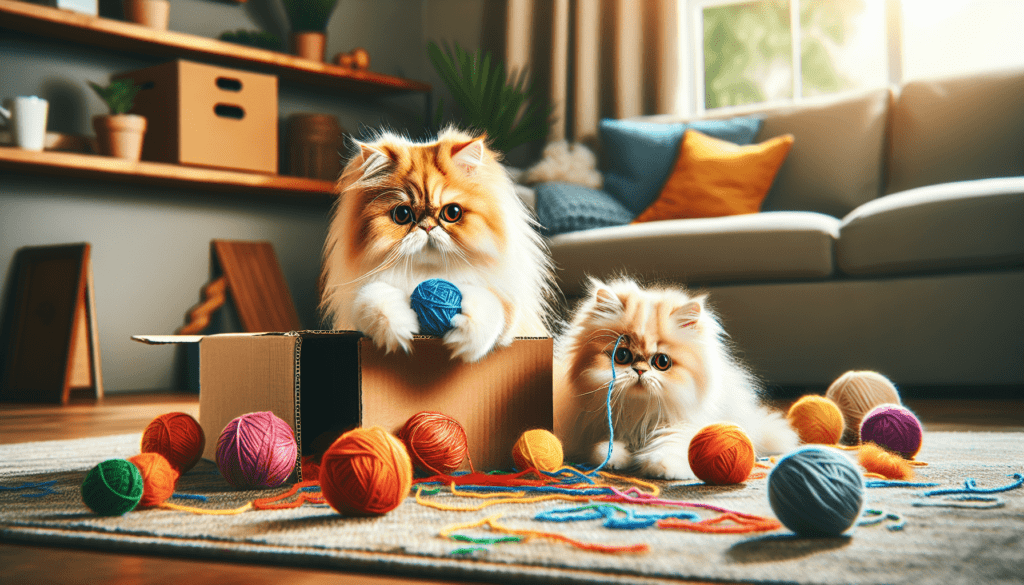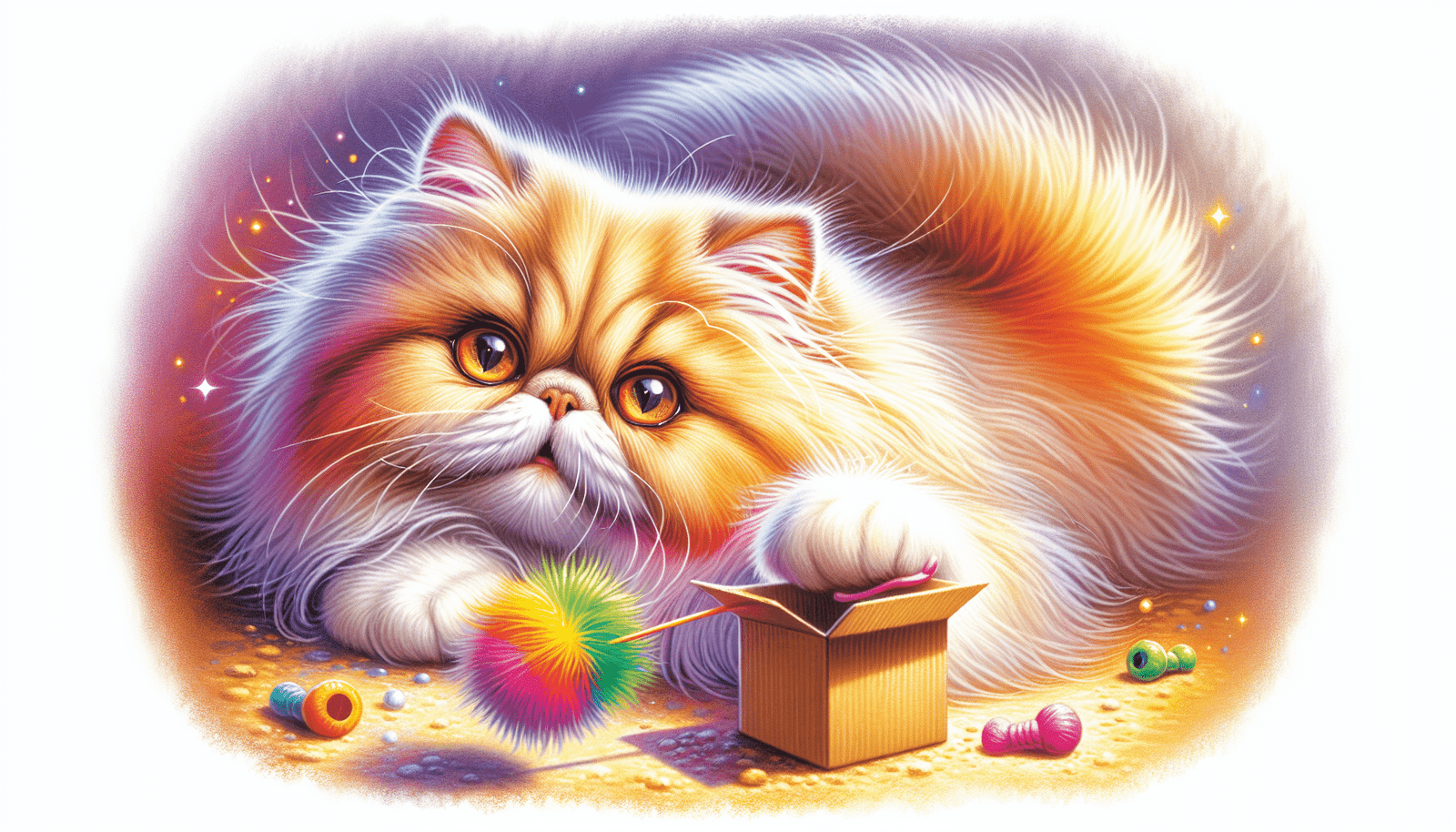Persian cats, renowned for their striking looks and luxurious coats, have always captured the hearts of cat lovers worldwide. Adored for their calm and gentle nature, these regal felines have a reputation for being independent and sophisticated. But have you ever wondered, beneath their elegant exteriors, are Persian cats playful? In this article, we will unveil the playful side of these majestic creatures, exploring their hidden mischievousness and surprising antics that will surely charm and entertain both owners and admirers alike. Get ready to discover a whole new dimension to these graceful companions!
Physical Characteristics of Persian Cats
Distinctive Appearance
Persian cats are known for their distinctive appearance. They have a round face with a short nose and large, round eyes that give them an adorable and somewhat serious expression. Their bodies are large and muscular, with a short, sturdy neck and a broad chest. Persian cats also have a stocky build and short legs, making them appear compact and solid.
Long Coat
One of the most notable physical characteristics of Persian cats is their long, luxurious coat. Their fur is thick and dense, with a silky texture that requires regular grooming to prevent matting and tangling. Persian cats come in various coat colors and patterns, including solid, tabby, calico, and colorpoint. The long coat adds to their regal and elegant appearance, making them a favorite among cat enthusiasts.
Flat Face
Another unique physical feature of Persian cats is their flat face, which is a result of selective breeding over the years. Their noses are short and pushed back, giving them a distinctively flat and “smushed” facial structure. This feature, known as brachycephaly, contributes to their adorable and doll-like appearance. However, it’s important to note that the flat face can sometimes lead to health issues, such as breathing difficulties and tear duct problems, so regular veterinary care is essential for Persian cats.
Temperament of Persian Cats
Generally Calm and Gentle
Persian cats are known for their calm and gentle temperament. They have a relaxed disposition and are typically not as active or energetic as some other cat breeds. They prefer a serene and peaceful environment, where they can lounge and enjoy their surroundings. Persian cats are often described as being quite laid-back and easygoing, which makes them great companions for people who appreciate a more relaxed lifestyle.
Affectionate and Loving
Despite their calm nature, Persian cats are incredibly affectionate and loving. They form strong bonds with their owners and enjoy being petted and cuddled. Persian cats are known for their sweet and gentle nature, and they often seek out human companionship. They thrive on attention and love to be in the company of their owners, making them perfect for people who want a cat that is loving and devoted.
Adaptable to Environment
Persian cats are highly adaptable and can thrive in various living environments. Whether you live in a small apartment or a spacious house, Persian cats will make themselves at home. They are not overly demanding and can adjust to different schedules and routines. However, it’s important to provide them with a peaceful and stress-free environment, as they can be sensitive to loud noises or chaotic surroundings.

Factors Influencing Playfulness
Individual Personality
Each Persian cat has its own unique personality, which can influence their playfulness. While some Persian cats may be more inclined to engage in play, others may have a more laid-back approach. Some cats are naturally more energetic and curious, while others prefer to spend their time lounging and observing. Understanding your Persian cat’s individual personality can help you gauge their level of playfulness and cater to their specific needs.
Socialization
Early socialization plays a crucial role in shaping a Persian cat’s playfulness. When Persian cats are exposed to various experiences and stimuli during their early stages of life, they are more likely to develop a playful nature. Socialization involves exposing them to different people, animals, and environments, which helps them build confidence and become more open to engaging in play. Proper socialization can enhance their overall well-being and increase their willingness to play.
Health and Age
The health and age of a Persian cat can also impact their playfulness. Cats that are in good health and free from any underlying medical conditions are generally more likely to have the energy and desire to engage in play. On the other hand, older Persian cats may have reduced mobility or age-related health issues, which can affect their playfulness. It’s essential to monitor your cat’s health and provide appropriate veterinary care to ensure they can enjoy a happy and playful life.
Playful Behaviors
Chasing Toys
Like many cats, Persian cats enjoy chasing toys. Whether it’s a feather wand, a string, or a small ball, they love the opportunity to pounce and chase after their prey. Engaging them in interactive play sessions where you move the toy around can provide mental and physical stimulation, as well as strengthen the bond between you and your cat.
Batting Objects
Persian cats have a natural instinct to bat at objects, which can be quite entertaining to watch. Tossing small, lightweight toys or balls for them to bat around can fulfill this natural play behavior. You can create a playful environment by scattering toys around the house or providing them with interactive objects, such as a puzzle feeder or a treat-dispensing toy.
Exploring
Persian cats have a curious nature and enjoy exploring their surroundings. Creating a safe and stimulating environment with plenty of hiding spots, climbing trees, and scratching posts can encourage their natural curiosity and playfulness. Allow them to investigate their environment at their own pace, and provide opportunities for them to discover new things.
Interactive Play
Interacting directly with your Persian cat through play is an excellent way to stimulate their mind and keep them entertained. This can involve using teaser toys to mimic prey movements, engaging in gentle play wrestling, or even teaching them simple tricks through positive reinforcement training. Interactive play not only keeps your Persian cat physically active but also strengthens the bond between you and your furry friend.

Exercise and Stimulation
Encouraging Play
To encourage play in Persian cats, it’s crucial to create a stimulating environment that sparks their interest. This can include providing a variety of toys, rotating them to maintain novelty, and engaging in regular interactive play sessions. Encouragement can also come in the form of positive reinforcement, such as praise or treats, whenever your cat exhibits playful behavior.
Providing Toys
Having a diverse range of toys is vital for keeping Persian cats entertained. Toys that mimic prey, such as wand toys with feathers or toys that make crinkling sounds, can be particularly intriguing to them. Puzzle toys and treat-dispensing toys can also keep their minds engaged and provide mental stimulation. Experimenting with different types of toys will help you determine your cat’s preferences and cater to their specific needs.
Playing Interactive Games
Interactive games can be a great way to provide both physical exercise and mental stimulation for Persian cats. Activities such as hide-and-seek, where you hide and encourage your cat to find you, or tossing toys for them to chase and retrieve can keep them engaged and entertained. Additionally, there are various digital interactive games designed for cats that can be accessed through tablets or smartphones.
Balancing Play and Rest
Understanding Cat’s Needs
It’s essential to understand that Persian cats, like all cats, have individual needs when it comes to play and rest. Some cats may prefer shorter, more frequent play sessions, while others might enjoy longer periods of play. Observing your cat’s behavior and cues will help you determine their playtime needs and strike the right balance between active play and sufficient rest.
Creating a Schedule
Establishing a playtime schedule can help ensure that your Persian cat gets the necessary exercise and stimulation without becoming overwhelmed. Determine the frequency and duration of play sessions based on your cat’s age, health, and energy levels. Consistency is key, as cats thrive on routine. By sticking to a schedule, you provide structure and predictability for your cat’s playtime.
Designating Play Areas
Having designated play areas within your home can help create a dedicated space for play and prevent disruptions during rest periods. These areas can be equipped with toys, scratching posts, and climbing structures to encourage your Persian cat to engage in play. By clearly defining play areas, you create an environment where your cat knows that it’s time for fun and play.
Playtime with Owners
Bonding through Play
Playtime with your Persian cat offers an excellent opportunity to bond and strengthen your relationship. By participating in interactive play sessions, you engage in shared activities that create positive associations and build trust. This bonding experience helps establish a deeper connection between you and your cat, fostering a loving and joyful companionship.
Engaging in Interactive Sessions
When engaging in play sessions with your Persian cat, it is important to actively participate and interact with them. Use interactive toys that allow you to play together, such as feather wands or laser pointers, and encourage your cat to chase and pounce. Respond to their play behaviors with enthusiasm, and make sure to include breaks for your cat to rest and recharge.
Understanding Cat’s Cues
During playtime, it’s essential to pay attention to your cat’s body language and cues. Cats communicate through various signals, and understanding these cues will help you gauge their comfort level and enjoyment. Signs of excitement and engagement may include an arched back, wagging tail, and focused attention. Conversely, signs of overstimulation or distress may include flattened ears, dilated pupils, or swishing tail. Respect your cat’s boundaries and adjust the play accordingly to ensure a positive experience for both of you.
Playtime with Other Pets
Encouraging Social Interactions
If you have other pets in your household, introducing playtime between your Persian cat and their furry companions can be a rewarding experience. Persian cats can enjoy interactive play sessions with dogs, as long as both animals are comfortable and familiar with each other. Supervised play allows the cats to engage in social interactions, promoting a sense of companionship and playfulness within the multi-pet household.
Supervising Play
When allowing your Persian cat to play with other pets, it’s crucial to closely supervise the interactions to ensure the safety and well-being of all animals involved. Observe their behavior and intervene if necessary, especially if play becomes overly rough or aggressive. By supervising play, you can foster positive social interactions and prevent any potential conflicts or injuries.
Introducing Properly
If you are introducing a new pet to your Persian cat, it’s essential to do so gradually and with care. Set up separate areas for each pet initially, allowing them to become familiar with each other’s scents without direct contact. Gradually introduce supervised play sessions, starting with short periods and gradually increasing the duration. Providing positive reinforcement, such as treats and praise, can help create positive associations and foster a harmonious relationship between your Persian cat and their new companion.
Health Benefits of Play
Physical Exercise
Regular play provides valuable physical exercise for Persian cats. Engaging in active play sessions helps them maintain a healthy weight, strengthens their muscles, and improves their overall physical well-being. Exercise also promotes good cardiovascular health and can help prevent conditions such as obesity and diabetes, which are more common in sedentary cats.
Mental Stimulation
Play is not only beneficial for the physical health of Persian cats but also essential for their mental well-being. Engaging in play stimulates their cognitive abilities, keeps their minds sharp, and prevents boredom. Puzzles, interactive toys, and play that mimics natural hunting behaviors provide mental challenges that keep their brains engaged and help prevent behavioral issues associated with boredom.
Preventing Obesity
Regular play and exercise are crucial for preventing obesity in Persian cats. Obesity can lead to various health problems, including joint issues, diabetes, and heart disease. By providing opportunities for physical activity and mental stimulation through play, you can help keep your Persian cat at a healthy weight and reduce the risk of obesity-related health concerns.
Improving Playfulness in Persian Cats
Regular Exercise Routine
Establishing a regular exercise routine is key to improving playfulness in Persian cats. Set aside dedicated time each day for interactive play sessions and provide opportunities for independent play with toys. Consistency is essential for maintaining their interest and enhancing their overall playfulness.
Introducing New Toys
Adding new toys to your Persian cat’s collection can help stimulate their curiosity and increase their playfulness. Rotate the toys regularly to maintain novelty and prevent boredom. Introducing different types of toys, such as puzzle toys, interactive feeders, or treat-dispensing toys, can provide mental stimulation and encourage active play.
Engaging in Interactive Play
Make an effort to actively engage in play with your Persian cat on a regular basis. Use interactive toys that allow you to participate in play sessions together, such as feather wands or interactive laser toys. Engaging in active play not only provides physical exercise but also strengthens the bond between you and your cat.
In conclusion, Persian cats have unique physical characteristics, a calm and gentle temperament, and can exhibit varying degrees of playfulness depending on individual factors. Understanding their needs, providing appropriate stimulation and exercise, and engaging in interactive play can help enhance their playfulness and overall well-being. By incorporating playtime into your daily routine and creating a stimulating environment, you can ensure that your Persian cat enjoys a happy and fulfilling life.

